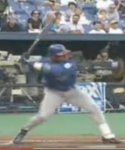
The pause is the launch position. Sosa has the hands higher and away from his body to start and then brings them down and in to reach the launch position. While Bonds has the hands lower and then raises them to reach the launch position. While the ideal launch position is at toe touch such as Bonds, the foot can still be in the air such as Sosa. Side by Side you can see them prepare the launch position, taking different paths to arrive in the same position.
An aspect of this that I have found interesting is how the hands work together with the body. After the pause, the hands continue to work up (hands getting loaded) as the rear shoulder works down and in.




